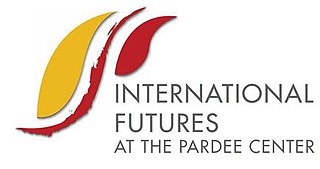Related Research Articles

The future is the time after the past and present. Its arrival is considered inevitable due to the existence of time and the laws of physics. Due to the apparent nature of reality and the unavoidability of the future, everything that currently exists and will exist can be categorized as either permanent, meaning that it will exist forever, or temporary, meaning that it will end. In the Occidental view, which uses a linear conception of time, the future is the portion of the projected timeline that is anticipated to occur. In special relativity, the future is considered absolute future, or the future light cone.
Marketing strategy is an organization's promotional efforts to allocate its resources across a wide range of platforms, channels to increase its sales and achieve sustainable competitive advantage within its corresponding market.
Scenario planning, scenario thinking, scenario analysis, scenario prediction and the scenario method all describe a strategic planning method that some organizations use to make flexible long-term plans. It is in large part an adaptation and generalization of classic methods used by military intelligence.
Futurists are people whose specialty or interest is futurology or the attempt to systematically explore predictions and possibilities about the future and how they can emerge from the present, whether that of human society in particular or of life on Earth in general.
Futures studies, futures research, futurism or futurology is the systematic, interdisciplinary and holistic study of social and technological advancement, and other environmental trends; often for the purpose of exploring how people will live and work in the future. Predictive techniques, such as forecasting, can be applied, but contemporary futures studies scholars emphasize the importance of systematically exploring alternatives. In general, it can be considered as a branch of the social sciences and an extension to the field of history. Futures studies seeks to understand what is likely to continue and what could plausibly change. Part of the discipline thus seeks a systematic and pattern-based understanding of past and present, and to explore the possibility of future events and trends.

Environmental Impact assessment (EIA) is the assessment of the environmental consequences of a plan, policy, program, or actual projects prior to the decision to move forward with the proposed action. In this context, the term "environmental impact assessment" is usually used when applied to actual projects by individuals or companies and the term "strategic environmental assessment" (SEA) applies to policies, plans and programmes most often proposed by organs of state. It is a tool of environmental management forming a part of project approval and decision-making. Environmental assessments may be governed by rules of administrative procedure regarding public participation and documentation of decision making, and may be subject to judicial review.
Strategic foresight is a planning-oriented discipline related to futures studies. In a business context, a more action-oriented approach has become well known as corporate foresight.

In futurology, especially in Europe, the term foresight has become widely used to describe activities such as:
Futures techniques used in the multi-disciplinary field of futurology by futurists in Americas and Australasia, and futurology by futurologists in EU, include a diverse range of forecasting methods, including anticipatory thinking, backcasting, simulation, and visioning. Some of the anticipatory methods include, the delphi method, causal layered analysis, environmental scanning, morphological analysis, and scenario planning.
Technology forecasting attempts to predict the future characteristics of useful technological machines, procedures or techniques. Researchers create technology forecasts based on past experience and current technological developments. Like other forecasts, technology forecasting can be helpful for both public and private organizations to make smart decisions. By analyzing future opportunities and threats, the forecaster can improve decisions in order to achieve maximum benefits. Today, most countries are experiencing huge social and economic changes, which heavily rely on technology development. By analyzing these changes, government and economic institutions could make plans for future developments. However, not all of historical data can be used for technology forecasting, forecasters also need to adopt advanced technology and quantitative modeling from experts’ researches and conclusions.
Backcasting is a planning method that starts with defining a desirable future and then works backwards to identify policies and programs that will connect that specified future to the present. The fundamentals of the method were outlined by John B. Robinson from the University of Waterloo in 1990. The fundamental question of backcasting asks: "if we want to attain a certain goal, what actions must be taken to get there?"

International Futures (IFs) is a global integrated assessment model designed to help with thinking strategically and systematically about key global systems. It is housed at the Frederick S. Pardee Center for International Futures. Initially created by Barry B. Hughes of the Josef Korbel School of International Studies at the University of Denver in Colorado, the model is free for public use in both its online and downloadable forms.
The following outline is provided as an overview of and topical guide to futures studies:
Corporate foresight has been conceptualised by strategic foresight practitioners and academics working and/or studying corporations as a set of practices, a set of capabilities and an ability of a firm. It enables firms to detect discontinuous change early, interpret its consequences for the firm, and inform future courses of action to ensure the long-term survival and success of the company.
Global Business Network (GBN) was a leading consulting firm that specialized in helping organizations to adapt and grow in an uncertain and volatile world. The firm was particularly well known for using tools such as scenario planning and also offered experiential learning with networks of experts and futurists.
Foresight: The Journal of Futures Studies, Strategic Thinking and Policy is an international bi-monthly journal published by the Emerald Publishing Group. The name connotes the term "foresight" as it is used in futures studies. Established in 1999, the journal provides a powerful framework and set of techniques that allow for understanding trends and drivers shaping the world, exploring alternative futures, setting priorities and formulating strategies for action. Foresight is a valuable source for futurists and foresight practitioners who should be at the forefront of discovering practical ways to manage 21st century life under growing complexity with a long-term perspective. The journal offers a much-needed forum for sound thinking about the future and socio-technological innovations, and focuses on themes and issues shaping the future, new quantitative and qualitative methods, as well as case studies with novel approaches. The journal is edited by Prof.Dr. Ozcan Saritas since 2009.
Causal layered analysis (CLA) is a technique used in strategic planning, futures studies and foresight to more effectively shape the future. The technique was pioneered by Sohail Inayatullah, a Pakistani-Australian futures studies researcher.
Threatcasting is a conceptual framework used to help multidisciplinary groups envision future scenarios. It is also a process that enables systematic planning against threats ten years in the future. Utilizing the threatcasting process, groups explore possible future threats and how to transform the future they desire into reality while avoiding undesired futures. Threatcasting is a continuous, multiple-step process with inputs from social science, technical research, cultural history, economics, trends, expert interviews, and science fiction storytelling. These inputs inform the exploration of potential visions of the future.

Mathew James Burrows is an American intelligence and strategic foresight expert and author.
Horizon scanning (HS) or horizon scan is a method from futures studies, sometimes regarded as a part of foresight. It is the early detection and assessment of emerging technologies or threats for mainly policy makers in a domain of choice. Such domains include agriculture, environmental studies, health care, biosecurity, and food safety.
References
- 1 2 Dator, Jim (July 2009). "Trend Analysis vs Emerging Issues Analysis" (PDF). Hawaii Research Center for Futures Studies. Retrieved June 28, 2014.
- ↑ "Glossary of futures studies terms". Audience Dialogue. Retrieved June 28, 2014.
- ↑ Inayatullah, Sohail. "Six pillars: futures thinking for transforming" (PDF). Foresight . doi:10.1108/14636680810855991. Archived from the original (PDF) on 2014-06-21.
- ↑ Lang, Trudi. "An Overview of Four Futures Methodologies" (PDF). Archived from the original (PDF) on July 6, 2017. Retrieved June 28, 2014.